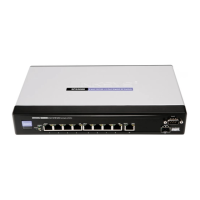Spanning Tree
STP Port Settings
SPS208G/SPS224G4/SPS2024 Service Provider Switches User Guide 192
10
-
Learning
— Indicates that the port is in Learning mode. The port cannot
forward traffic, however it can learn new MAC addresses.
-
Forwarding
— Indicates that the port is in Forwarding mode. The port
can forward traffic and learn new MAC addresses.
• Speed — Indicates the speed at which the port is operating.
• Path Cost — Indicates the port contribution to the root path cost. The path
cost is used for forwarding traffic.
• Default Path Cost — When checked, returns the path cost to its default
value.
• Root Guard — Enables or disables Root Guard, which prevents devices
outside the network core from being assigned the spanning tree root. The
possible field values are:
-
Enable
— Indicates that Root Guard is enabled on the selected port or
LAG.
-
Disable
— Indicates that Root Guard is disabled on the selected port or
LAG. This is the default value.
• Priority — Priority value of the port. The priority value influences the port
choice when a bridge has two paths to the root. The priority value is
between 0-240. The priority value is provided in increments of 16.
• Designated Bridge ID — DIsplays the bridge priority and the MAC Address
of the designated bridge.
• Designated Port ID — DIsplays the designated port’s priority and interface.
• Designated Cost — DIsplays the cost of the designated port participating
in the STP topology. Ports with a lower cost are less likely to be blocked if
STP detects loops.
• Forward Transitions — DIsplays the number of times the port has changed
from the Blocking state to Forwarding state.
STEP 2 Define the relevant fields.
STEP 3 Click Update. The interface STP configuration is defined and is displayed in the
STP Port Table.
STEP 4 Click Save Settings. The STP configuration is saved and the device is updated.

